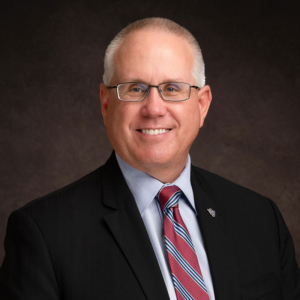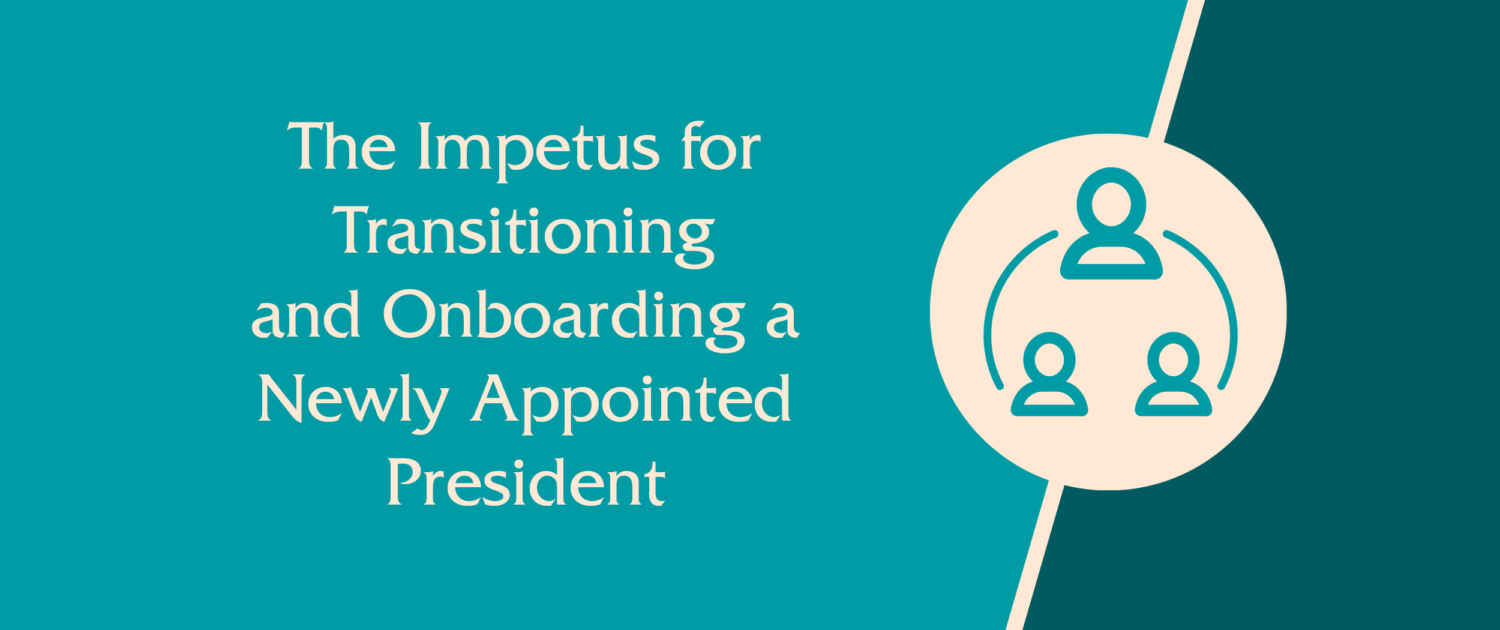The Changing College Presidency and How Executive Coaching Can Help
By Chris R. Groscurth, Ph.D., PCC, and Steven E. Titus, J.D., Ph.D. | January 2023
Consider a day in the life of a college president: It starts with a cabinet meeting. Then a meeting with a cross-campus committee of deans. Next up, taking pressing questions from a student group. Then it’s off to lunch with a trustee who is in town, followed by two back-to-back Zoom calls, a financial review with your VP of Finance in preparation for an upcoming board meeting, and then back across campus to dedicate and recognize the hard work on a new installation on campus. Finally, the commitment that you’ve really been excited about, attending a student symphony at the School of Music, Theatre, and Dance at 7:00 p.m.
If you talk to a university president, you’ll hear that there is never enough time in a day, money, or openness to change. The presidency is an endless job of fundraising, financial management, recruitment, crisis management, and juggling multiple constituents. At the same time, presidents describe the presidency as an honor, a privilege, a form of service, and even an expression of their highest “calling.”
There is no doubt that the college presidency is unlike any executive office in the corporate or non-profit sectors. According to ACE, “College and university presidents occupy a leadership role unlike any other. They play a critical role in ensuring their institution’s success, especially as internal and external pressures have grown at a time of resource instability and demographic change” (ACE, 2022).
In addition to the current climate of resource instability and demographic change, presidents are faced with headwinds related to social, technological, political, and declining public perception of higher education. Together, these factors (and many more) account for the changing nature of the college and university presidency.
The changing nature of this office has been well-documented by the American Council on Education (ACE), the Association of Governing Boards of Universities and Colleges (AGB), and Deloitte. We value the insights from this body of work and do not have space to thoroughly review it in the space of a blog post.
In this article, we will briefly review the external and internal forces that are exerting change on college and university presidency and reflect on how executive coaching is helping presidents navigate the changing nature of the presidency.
External Influences on the Presidency
- Funding—According the ACE, 65% of college presidents identify budget and financial management as an area that occupies most of their time. The second most time-consuming area identified by presidents was fundraising. Lack of funding was also the top frustration among college and university presidents. Ensuring the means for institutional survival demands constant communication and “selling” the institution’s value to a number of stakeholders: alumni/ae, donors, current students, prospective students, faculty, and staff.
- Technology—Changes in technology are not unique to academic leadership. However, technological change has increased the velocity of change that presidents and their cabinets face. According to Deloitte University (2017), technology is impacting nearly every facet of higher education, from how teaching and learning occur, to how faculty and staff work. The ability to influence and align stakeholders on issues of technology is essential for the strategic and operational success in areas such as recruitment, finance, advancement, marketing, and student learning. Balancing short-term wins and long-term technological investments in an era of scare resources often creates both headaches and exciting opportunities for university presidents.
- Politics—Public and private institutions face different political (Big “P”) challenges with respect to state legislatures and elected governing boards. However, all presidents are navigating increasingly divided political attitudes on a variety of complex topics ranging from the pandemic and public health, to race relations and public safety, abortion rights, climate change, and diversity, equity and inclusion. Listening to multiple political points of view, while having the courage to take a political stance in defense of their institutions mission and values are essential demands of the presidency that are tested, often publicly, on a daily basis.
- Public Opinion—According to Gallup and the Pew Research Center, public confidence in higher education and its role in American society has been declining for some time (Jaschick, 2018). However, there may be hope for university presidents. According to a January 2022 Whiston poll for the American Council on Education, more than a third (38%) of survey participants felt the value of a college degree had increased over the past 20 years. This was an 11% improvement in public opinion of higher education from 2018. However, 38% of respondents still believe that the value of a college degree has decreased over the past 20 years (10% improvement over 2018). Public opinion provides an external gauge on how prospective students and their families feel about the value proposition of higher education. According to the AGB, public opinion can help presidents and governing boards clarify their expectations of one another.
Internal Influences on the Presidency
The external influences on the presidency noted above create internal pressure for university presidents to ensure and improve the institution’s health.
- Financial Management—At the heart of the higher education business model is net revenue per student. It is the sum of revenue from student tuition and fees minus financial aid provided. Attracting, enrolling, and retaining students are the fundamental levers for maintaining healthy revenue from tuition. According to AGB’s report on The 21st Century Presidency, “The era of presidents who could expect to preside over an adequately funded and fundamentally stable enterprise is gone” (p. 21). As such, presidents must develop the capacity to transform their legacy academic culture so that they can ensure the viability of their institution amidst the realities of today, allocate resources appropriately, and capitalize on future opportunities.
- Managing an Executive Team—Given the complexities and forces at play mentioned thus far, a president must have a healthy, high-performing senior leadership team. According to ACE’s survey of university presidents, 42% report that managing a senior level team is the area that occupies most of their time. Managing a top team starts with attracting great talent to the institution, on- boarding those leaders, and providing on-going development and coaching to ensure their success. For many presidents, the capabilities required to manage and lead a high-performing team are learned through experience, observation, and trial and error. According to Deloitte’s “Pathways to the University Presidency” research, presidents believe “leadership development” training is among the most needed form of professional development second only to fundraising.
- Enrollment, Retention, & Graduation—Students are at the heart of higher education. No students, no college. Therefore, facilitating collaboration across enrollment, finance, student affairs, and academic affairs is critical to creating an institution that attracts and supports students throughout the university experience. The president must ensure that all stakeholders keep “the big picture” in mind and address enrollment, retention, and graduation in a wholistic manner, acknowledging the realities of today while building for the future.
- Fundraising—As state and federal funding for higher education in the United States declines and net tuition revenue, despite increases, fails to meet the financial needs of running a university, endowments, private gifts, grants, and contracts are critical sources of funding for college and universities. According to Deloitte’s survey of university presidents, 65% believe that fundraising/alumni/ donor relations rank among the most important responsibilities in their current role, and 50% believe that fundraising has increased in importance since they assumed their role. What’s more, presidents reported that fundraising/advancement were the most important areas for their own development, and the area in which they felt ill-prepare to provide executive leadership.
- Diversity, Equity & Inclusion (DE&I)—According to ACE, 92% of college presidents think it is important or very important for presidents to make clear, public statements about the status of racial minorities on campus. And 45% of college presidents lead institutions that have initiatives to attract both female and racial minority faculty. Attracting, developing, and retaining diverse faculty, students, and staff are of increasing importance to the majority of college presidents because they are key to managing both external and internal influences on the changing higher education landscape. Interestingly, while ACE provides insights on how presidents think about DE&I, and how initiatives focusing on DE&I are trending on university campuses, neither the Deloitte study nor the ACE studies from 2017 placed DE&I as an area that occupies most of a president’s time.
Five Ways Executive Coaching Can Help Presidents
There is no singular pathway to the university presidency, and the office itself comes with little formal leadership development. Unfortunately, attitudes about leadership development and funding for it in higher education has lagged behind the corporate and non-profit sectors.
However, the leadership development tides are beginning to shift in higher education. In addition to traditional leadership “seminars” and “institutes,” higher education presidents and their boards are recognizing the importance of development planning, leadership assessment, and executive coaching for presidents and senior leaders.
As senior executive coaches we view our roles as companions, guides, and strategic advisors committed to the success of the leaders with whom we partner. Presidents come to coaching for a variety of personal and professional reasons, including:
- A confidential sounding board for developing vision and strategy.
- Advice about organizational structure or design to fill institutional gaps or leverage institutional assets.
- Guidance in working with direct reports and teams to meet the leader’s expectation and agenda for success.
- Assistance in cultivating and strengthening important relationships such as a Board, elected officials, major donors, industry partners, faculty leaders, and others whose support is essential to a president’s success.
We believe executive coaching is a valuable institutional tool for helping colleges and universities manage the changing nature of the presidency and of higher education leadership in general.
Below we’ve outlined five ways in which executive coaching can be helpful.
- Preparing Future Presidents—For those willing to take on the demands of being a university president, executive coaching can be a valuable tool. First, it can help aspiring leaders objectively assess their strengths and opportunities for deeper growth. Executive coaching can also help an aspiring president discern whether the presidency is the right path for them. Finally, and perhaps most importantly, executive coaching can facilitate deeper learning from on-the-job experiences and stretch assignments along the pathway to the presidency.
- Transition and On-Boarding—Once an institution has invested in the search for and selection of a new president, they should insure their investment in the new president. Formal transition teams have traditionally served this purpose. Executive coaching can complement formal transition planning for new presidents. The role of the executive coach is that of a strategic partner for the new president and his or her team. Executive coaches provide a structured approach to individual leadership and team effectiveness, which might include leadership development planning, new leader assimilation workshops facilitated by an executive coach, formal assessment of leadership strengths, 360 feedback within the first year, team retreats, and monthly 1:1 executive coaching sessions on targeted topics (e.g., staying well, board relations, stakeholder management, senior team dynamics, and/or personnel/ performance management matters).
- Experienced Presidential Coaching—Experienced presidents often make use of executive coaches to build on their leadership successes and strengths and address areas for growth. In addition, governing boards are using executive coaching to attract, strengthen, and retain top leadership talent. The value that the president brings to the executive coaching partnership is their understanding of their wants, needs, and goals for their institution. The value that the executive coach brings to the partnership is their expertise in the coaching process, cross-institutional perspective, professional standards, code of ethics, and skillful use of executive coaching tools to help leaders make the best decisions for their institutions amidst uncertainty. Executive coaches also provide a level of accountability and candid feedback that is often lacking from members of their senior team or board.
- Team Effectiveness—Individual executive coaching engagements may or may not explicitly involve members of the presidential cabinet. When the president’s team is directly engaged in a presidential coaching engagement, they are invited to provide input and feedback on the team’s overall engagement and effectiveness, and take ownership of strategies and solutions to improve the team’s effectiveness. Executive coaches provide team coaching through executive team retreats, planning meetings, strategy reviews, and smaller team coaching sessions designed to help improve prioritization, clarify expectations, accountability and performance, and facilitate team collaboration and cohesion.
- Culture and Institutional Health—Executive coaches can help presidents evolve their culture and promote effective organizational behavior. Executive coaches are often engaged to help facilitate and improve communication between specific stakeholders or stakeholder groups. Executive coaches use a variety of individual, team, and organizational assessments to diagnose strengths and opportunities, facilitate visioning and future-state discussions, and help top executives create plans of action, metrics, and measures of accountability that drive the organization forward.
Closing Thoughts
The unique demands on a university president are becoming increasingly complex and multifaceted. A strong, adaptive, and sustainable institution necessarily depends on strong, adaptive, and sustainable leaders. We believe, as do our partner institutions across the U.S. and world, that executive coaching is critical for sustaining effective leadership amidst the transformations occurring in higher education.
About the Authors

Chris R. Groscurth, Ph.D., PCC
Executive Coaching Advisory Board Member
Dr. Chris R. Gorscurth is a member of Academic Search’s Executive Coaching Practice Advisory Board. He is a former Gallup-Certified Strengths Coach, certified Clifton Strengths® coach, professional certified coach (PCC) through the International Coach Federation, and author of the book Future-Ready Leadership: Strategies for the Fourth Industrial Revolution.

Steven E. Titus, J.D., Ph.D.
Vice President and Executive Coaching Practice Leader
Dr. Steven E. Titus is President Emeritus of Iowa Wesleyan University, a Gallup-Certified Strengths Coach, Certified Executive Coach, member of the International Coaching Federation, and Senior Fellow of the Institute of Coaching.








